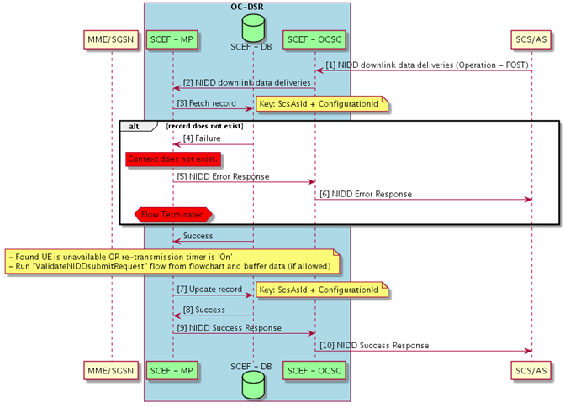| Oracle® Communications Diameter Signaling Router Service Capability Exposure Function User's Guide Release 8.4 F12301-02 |
|
 Previous |
 Next |
| Oracle® Communications Diameter Signaling Router Service Capability Exposure Function User's Guide Release 8.4 F12301-02 |
|
 Previous |
 Next |
Figure 2-6 illustrates the procedure SCS/AS uses to send non-IP data to a given user as identified using the External Identifier or MSISDN.
If SCS/AS has already activated the NIDD service for a given UE, and has downlink non-IP data to send to the UE, the SCS/AS sends an NIDD Submit Request containing the External Identifier or MSISDN and the non-IP data message to the SCEF.
Figure 2-6 Downlink Data Delivery

If an SCEF EPS bearer context corresponding to the External Identifier or MSISDN is found and the UE, according to the context of SCEF, is currently in a connected/reachable state, the SCEF determines whether the data delivery message rate is within the configured APN downlink rate and the Serving PLMN rate as received in the T6a/T6b connection establishment request from the MME/SGSN. If the SCEF finds the downlink data delivery message is within the rate thresholds, it attempts to send a Mobile Terminating Data message to the MME/SGSN. The SCEF also informs the MME/SGSN of the duration of time that it can wait for a response from the MME/SGSN and the duration of time up to which it can re-attempt to send the data messages. If the MME/SGSN finds the UE to be in a connected state, it attempts to deliver the data message to the UE. If the MME/SGSN cannot deliver the message within the time mentioned by the SCEF, it responds with an appropriate cause "UE temporarily not reachable." If the MME/SGSN knows when the UE is expected to be in connected state, it may inform the same to the SCEF in the Requested-Retransmission-Time parameter of the response. If the MME/SGSN is not aware when the UE may be reachable again, it stores, in its context, the SCEF Identity so that it can inform the SCEF when the UE becomes reachable.
If the SCEF does not a have an EPS bearer setup for the UE, the UE is not reachable, or the response from the MME/SGSN indicates the UE is not currently reachable, the SCEF tries to buffer the downlink data message. If the data message could be successfully buffered by SCEF, it responds with the 202 Accepted code to the SCS/AS and indicates the data is buffered. If the SCEF could not buffer the message, it indicates the cause of failure to the SCS/AS.
Data Buffering at SCEF
Figure 2-7 SCEF Buffering Downlink Data as UE is Not Available

Downlink data is buffered by SCEF under these conditions:
When there is no PDN connection with the MME/SGSN, the PDN Establishment Option is considered in the following order of preference (most preferred first) to decide whether or not to buffer the data:
The UE reachability status has not been updated further by the MME/SGSN. In this case the SCEF does not attempt to send a data delivery request to MME/SGSN, rather it tries to buffer the data as soon as it receives it from SCS/AS.
The following conditions need to be met for the downlink data to be buffered by SCEF:
This data duration configuration can be found in the NIDD Configuration Set managed object and has a default value of 0, that is, Data Buffering is disabled by default.
The minimum retransmission time can be configured in the NIDD Configuration Set managed object and has a default value of 5 seconds.
This configuration can be found in the APN Configuration Set managed object with the default value of 100 bytes.
The length of the queue is configurable in the NIDD Configuration Set managed object with a default value of 1.
While attempting to buffer a downlink data message, assuming that all other conditions listed are found to be satisfactory, however, the queue is found to be full and the data message attempting to getting buffered has a higher priority than any message already present in the queue, the higher priority data message takes the place of the lowest priority message. A data delivery status notification shall be sent to the SCS/AS with a cause of "FAILURE" for the message that exists in the queue.
SCEF generates a Downlink Data Delivery ID for downlink data messages that are buffered, if the request does not already have it in the URI.
Any downlink data message that is buffered at SCEF resides in the data delivery queue for a maximum time as indicated by Maximum Latency attribute of the message. The maximum time is further capped by the data duration configuration parameter in the NIDD Configuration Set managed object.
Data Retransmissions
SCEF attempts to retransmit data messages that it has buffered in these scenarios:
Downlink Data Delivery Status Notification
The downlink data messages that are buffered by SCEF are either retransmitted or they expire sitting in the delivery queue. In either case, a Downlink Data Delivery Status notification is generated by SCEF and sent to the SCS/AS using the DSR API Gateway. The SCEF used the Notification Destination Address provided by the SCS/AS at the time of NIDD configuration, if provided, or the configuration in the SCS/AS managed object.
The status notification may contain one of these codes:
The SCEF included the Downlink Data Delivery ID of the data message in the notification for the SCS/AS to identify the same.